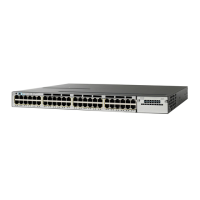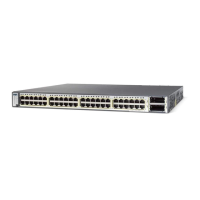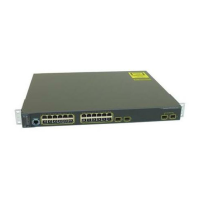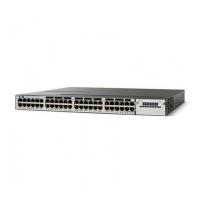B-9
Catalyst 3750-X and 3560-X Switch Software Configuration Guide
OL-21521-01
Appendix B Working with the Cisco IOS File System, Configuration Files, and Software Images
Working with Configuration Files
This example shows how to display the contents of a configuration file on a TFTP server:
Switch# more tftp://serverA/hampton/savedconfig
!
! Saved configuration on server
!
version 12.2
service timestamps log datetime localtime
service linenumber
service udp-small-servers
service pt-vty-logging
!
<output truncated>
Working with Configuration Files
This section describes how to create, load, and maintain configuration files.
Note For information about configuration files in switch stacks, see the “Switch Stack Configuration Files”
section on page 5-15.
Configuration files contain commands entered to customize the function of the Cisco IOS software. A
w
ay to create a basic configuration file is to use the setup program or to enter the setup privileged EXEC
command. For more information, see Chapter 3, “Assigning the Switch IP Address and Default
Gateway.”
You can copy (do
wnload) configuration files from a TFTP, FTP, or RCP server to the running
configuration or startup configuration of the switch. You might want to perform this for one of these
reasons:
• To restore a backed-up configuration file.
• To use the configuration file for another switch. For example, you might add another switch to your
network and want it to have a configuration similar to the original switch. By copying the file to the
new switch, you can change the relevant parts rather than recreating the whole file.
• To load the same configuration commands on all the switches in your network so that all the
switches have similar configurations.
You can copy (u
pload) configuration files from the switch to a file server by using TFTP, FTP, or RCP.
You might perform this task to back up a current configuration file to a server before changing its
contents so that you can later restore the original configuration file from the server.
The protocol you use depends on which type of server you are using. The FTP and RCP transport
mechanisms pro
vide faster performance and more reliable delivery of data than TFTP. These
improvements are possible because FTP and RCP are built on and use the TCP/IP stack, which is
connection-oriented.
These sections contain this co
nfiguration information:
• Guidelines for Creating and Using Configuration Files, page B-10
• Configuration File Types and Location, page B-10
• Creating a Configuration File By Using a Text Editor, page B-11
• Copying Configuration Files By Using TFTP, page B-11
• Copying Configuration Files By Using FTP, page B-13

